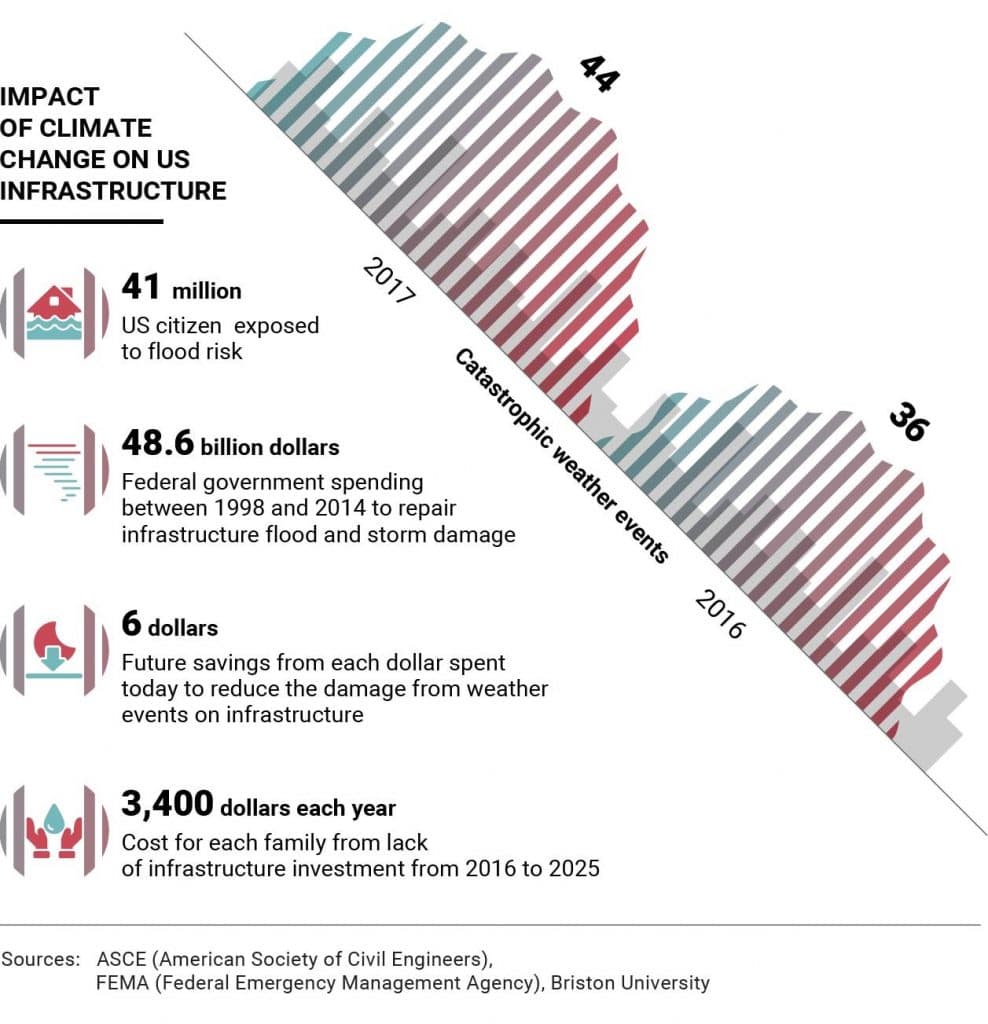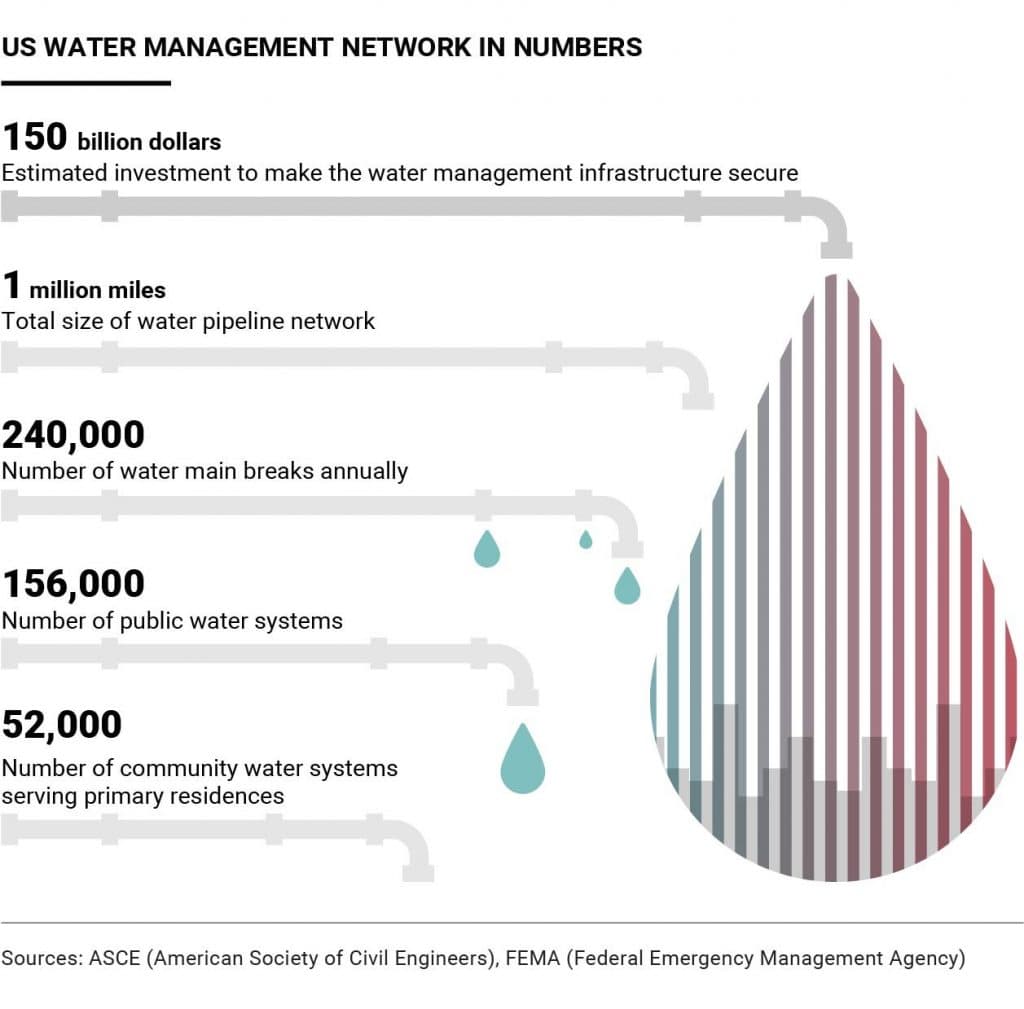
Harvey, Irma, Maria, Nate. People in the United States will not forget these names any time soon: they belong to the worst hurricanes experienced by the US in recent memory. Their damage is just the tip of a much larger and more dangerous iceberg looming to wreak havoc on water resources management in the USA in the future because of global warming and the resulting climate changes. Water infrastructure is particularly vulnerable and therefore it is crucial to deal with this growing threat.
The Federal Emergency Management Agency, or FEMA, recently published a draft document of its “National Mitigation Investment Strategy,” outlining a to-do list of actions it plans to take to reduce the negative impact of weather threats to as low as possible. The final plan will be released in the fall.
Indeed, according to records kept by the US Federal government, there were 44 catastrophic weather events in 2017, including floods and hurricanes, a 20% increase over the 36 catastrophes in 2016.
The problem touches millions of people. According to the study “Estimates of Present and Future Flood Risk in the Conterminous United States” carried out by the University of Bristol in the UK, 41 million Americans are exposed to floods – a number that is as much as three times higher number than previously estimated.
The increasing risk has alarmed federal and state authorities, which have already been working on better water management for years with investments to shore up ageing infrastructure.
Risk of floods
The majority of US water infrastructure (water mains, dams, levees, and ports) was built in the first half of the 20th century, as Ryan Fischer, Principal Deputy Assistant to the US Defense Secretary, told the Senate Committee on Environment and Public Works on January 17. Flooding is a significant threat to all sorts of US infrastructure assets, from streets to bridges, from rivers to water treatment plants. From 1998 to 2014, FEMA invested $48.6 billion in a public spending program to restructure buildings, streets, bridges, dams and other infrastructure damaged by storms or flooding.
But FEMA’s spending program, even though it has a wide range of targets, is just a small part of the profuse effort needed in the US to combat the disastrous effects of climate change.

Huge investments are needed
FEMA has insisted many times that investment in US water management infrastructure is not only necessary but will result in significant savings over the long term. For every dollar invested today to reduce damage from weather catastrophes, $6 is saved in the future on repairs resulting from weather damage, according to the National Institute of Building Sciences.
In terms of investment, the first goal is to close the enormous gap between the current state of water infrastructure and an optimum state to survive climate change – a problem which involves everything from drinking water pipes to reservoir levees and dams.
The American Society of Civil Engineers (ASCE) said in its most recent “Failure to Act” report in 2016 that water infrastructure has remained stable or improved only modestly in the past four years. This lack of progress has an economic cost: the report estimates a cost to families from crumbling water, energy and transport infrastructure of $3,500 per year from 2016-2025, and of $5,100 per year from 2026-2040.

US water infrastructure is a vast asset to be protected
The US water management infrastructure is a total of one million miles long, and is made up of 156,000 public water systems, 52,000 of which are community systems that serve the primary residences of at least 286 million Americans. The remaining water mains serve facilities like farms, gas stations, hospitals, schools, companies and industries. This vast infrastructure suffers from a significant lack of investment. According to the ASCE, there have been an average of 240,000 water main breaks annually in recent years, for a loss of nearly 7.5 trillion litres.
To bring this network up to an optimum level of security, an investment of $150 billion is needed from 2016 to 2025, according to ASCE – which works out to a gap of $105 billion at planned spending levels.
This lack of investment affects not just the quality of infrastructure and its ability to function, but will also have a negative impact on GDP, causing the US economy to lose $4 trillion from now to 2025 if this gap is not addressed.
So there is a danger that if nothing is done now, the entire US economy itself could soon be under water.


